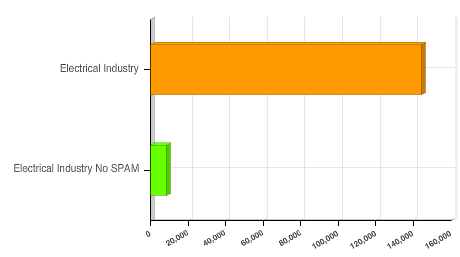Social Spam: Don’t let spammers interrupt your customer conversations
I have a good buddy, and our friendship dates way back to middle school. We don’t get to talk on the phone much anymore, but when we do, I really value it. Just getting to focus on him and his BUY VIAGRA! life and see how YOU SHOULD BEGIN WITH CHEAP RALPH LAUREN CLOTHES!
As you can see, the topic of today’s MarketingSherpa blog post is social spam. Social media is, inherently, a conversation. And, some marketers really understand that. They speak to their customers, listen to them, and don’t engage in antisocial media.
Even for the marketers who do get it, it’s so frustrating to deal with social spam. You’re trying to have a real conversation with your customers, and then some knucklehead autobot posts 50 comments about cheap Ralph Lauren clothes.
It’s an issue we deal with here on the MarketingSherpa blog. We use Akismet to filter out obvious spam, and monitor the rest of the comments manually. We have a high standard, so occasionally real comments get accidentally blocked (if that ever happens to you, just email me). Our goal is to make sure you draw value from the conversations taking place on this blog, not to simply up our comment counter.
To help you deal with social spam in your own social media marketing efforts, I talked to a few experts in the field.
The social spam challenge
“Email spam is a well-understood problem for which a large number of commercial solutions exist,” said Mark Risher, co-founder and CEO, Impermium. “Conversely, it’s still early days for social spam. Most social platforms lack an adequate content cleansing solution to address the multiple forms of abuse.”
That is why social spam is so prevalent. Mandi Frishman, Marketing Manager, Make Me Social, ran a quick test for the MarketingSherpa blog.
“I just went to Pinterest and typed ‘eggplant’ into the search bar. Of the first 14 pins, eight were from spam accounts. I’m overwhelmed by the sheer volume of social spam that I see each day, especially when running data pulls on behalf of clients.”
Of course, Pinterest isn’t the only social sharing website facing this challenge. Tim Howell, Community Manager, Make Me Social, created a brief chart showing the prevalence of spam and Tweet Zombies in the electrical industry.
“We pulled 60 days’ worth of data from Twitter, which is typically the most common source of social spam,” he said.
“In the first pull, we brought in the full, unfiltered flow of posts from Twitter on a wide range of topics, brands and products in the electrical industry,” Tim said. “For the second pull, we applied a few filters to remove the most common signs of spam activity. It’s nearly impossible to remove all spam posts from this data, but even the most basic filters reduced the amount of spam by over 130,000 posts.”
But, you don’t only have to worry about competing with social spam on well-known social networking services — you have to keep your own sites clean as well.
“It not only plagues major platforms like Twitter and Facebook, but it affects the comment sections and forum boards of practically every news site and blog with a decent page rank,” Mark said.
“The Q1 samples we pulled from the Impermium global defense network revealed 4-8% of social Web traffic is spam, up from 2-5% just six months prior. While these numbers may sound relatively small, consider that in 2011, 90% of all social media users experienced some form abuse.”
So social spam is clearly a problem, but why should marketers care?
Well, for one, social spam can hurt your SEO efforts. “Every signal we get from Matt Cutts at Google and other search engine gurus tells us that UGC (user-generated content) is fair game in their ranking methodology, and we must be ever more mindful of every piece of content on our sites, social or not,” Mark said.
It also hurts your ability to measure your social media efforts. “An audit of Impermium’s Q3 2011 data showed that between 5 and 40% of all social user accounts are fake. Including these bogus users in Web analytics can produce a woefully inaccurate picture of your business,” Mark added.
Lastly, there is the trust factor. Would you really value any of the information on the MarketingSherpa blog if the comment section was littered with ads for porn, pharmaceuticals, dating sites and discount sales?
How can marketers fight back?
There are no easy answers to this question. Email spam has been around for quite a while, and it is still a nuisance. Literally, while I was writing this, Debi Johnson, Events Manager, MECLABS, swung by my office bragging about how, according to an email, she might be inheriting $17.5 million, since the client of a Nigerian attorney died. And, you see, she shares the same last name as this deceased millionaire.
So what can you do?
“Marketers need to stay vigilant, monitor mentions of clients to quickly identify fake accounts that could have a negative impact on brand reputation, and set up filters to ensure good-quality data,” Mandi said.
By adding a challenge-response test to the post a comment section of MarketingSherpa articles, we’ve seen a significant drop in the amount of spam comments.
However, an automated spam tool does risk false positives or being hacked itself.
“One recent study found that the use of CAPTCHA can cause a 15% drop-off in legitimate user conversion, while the black-market price for automated CAPTCHA ‘cracking’ is as low as $1 per 1,000 spam posts,” according to Mark.
We use manual moderation as well. This could be a good fit for an administrative assistant, customer service rep or intern in your organization. Of course, the downside is that this isn’t scalable and involves costs of its own.
“I recommend that marketing managers explore external anti-abuse systems that leverage reputational and behavioral monitoring techniques — weighing the context of the posting alongside the content — to effectively detect and block abusive content,” Mark advied. (Full Disclosure: Mark’s company sells a social content cleansing platform.)
Lastly, we can all band together in a marketing version of, “If you see something, say something.”
“Every so often I’ll go on a ‘report spammer’ kick and feel like I’ve accomplished something — until the next hundred spammers show up,” Mandi admitted.
How do you fight social spam? And how successful have you been? Let us know in the comments section of this blog post. However, if your comment focuses on how I can acquire my favorite Chanel bag, it will be summarily blocked and deleted.
Related Resources:
Social Spam: Why you should clean out your LinkedIn and Facebook communities
Halloween Edition of Impermium Index Reveals Social Spam Goblins Galore
Built to Scale: Social Media Symbiosis
reCAPTCHA (a free anti-bot service that helps digitize books)
Categories: Social Networking Evangelism Community social media monitoring, social spam, user generated content













I love it when people take the time to reply to blogs or posts. Sadly, we’ve also seen an increase in spam posts on our blog. On our site we’ve started using Askismet as well, but do worry about false positives. It’s a pain to go back and manually monitor, but I guess it’s the price of open communications.
It’s probably worse lately in a few (but not all) groups we’ve added comments/questions on in LinkedIn. If you’re not the group manager, it’s also harder to deal with. Hopefully there will be a better solution there soon.
Thank you, Daniel, for including Impermium in this social spam summary. As the bad guys’ attacks increase in sophistication, they’re increasingly making it past the simple blog spam filters and defeating CAPTCHA. Mandi puts it well: Marketers need to stay vigilant, examine many attributes of each transaction, and not get lulled into a false sense of security with a single, silver-bullet technique.